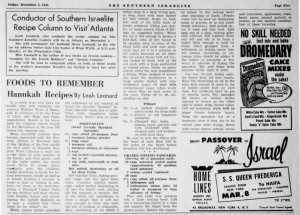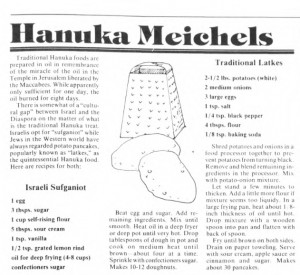
The first night of Hanukkah in 2011 begins on Tuesday, December 20. It is one of the best known Jewish holidays in the United States, despite the fact that it is of lesser religious significance than major holidays, such as Rosh Hashanah, Yom Kippur, and Passover. The events commemorated by the celebration of Hanukkah do not appear in Hebrew sacred scriptures, or tanakh, because they took place after the closure of the Hebrew biblical canon. But Hanukkah has remained an eight-day holiday where Jews celebrate their victory over an emperor who tried to destroy their identity and culture; the rededication of the Temple in Jerusalem, and how a small quantity of oil for the Temple’s menorah miraculously lasted eight days; this legend is known as the miracle of the oil. The December 17, 1954 edition of the weekly edition of the Southern Israelite features a “Hanukah Quiz” prepared by Rabbi S. J. Fox that tailors three questions and answers to educate young readers about the miracle of the oil (in the article, Hanukah is spelled with one k).
The word “hanukkah” means “dedication” in Hebrew, and marks the reconsecration of the Temple in Jerusalem in 165 BCE. During the second century BCE, under the rule of the emperor Antiochus, Syrian Greeks forced Jews to assimilate into Hellenic culture by making the observance of Judaism an offense punishable by death. The Temple, central to Jewish scripture and life, was desecrated by the Greeks, who sacrificed non-kosher animals at its altar, and used it to worship Greek gods. The Temple was recovered when the Maccabees, a small Jewish army, led a successful rebellion against the much larger Greek military forces and subsequently restored religious freedom for Jews in the Holy Land.
When the Temple was cleaned and rededicated by the Maccabees, its menorah had to be lit with oil that had been ritually purified and sealed by a rabbi. The Maccabees could only find enough purified oil to last one day, and it would take eight more days to produce more under proper ritual standards. Somehow, the one-day supply of oil lasted eight days. To commemorate this event, Jews observe Hanukkah for eight nights by lighting a menorah, a nine-branched candelabrum also known as a hanukiah, to distinguish it from the seven-branch menorah in the Temple. Eight branches of the menorah represent the extra days the temple oil lasted; the ninth branch is for a shamash, or servant candle, which is used to light the others. Starting with a single light on the first night, a new light is added each evening of the celebration. On the eighth night, all nine lights (the eight Hanukkah lights and the shamash) are lit. More traditional menorahs are designed to hold oil and floating wicks, while newer ones hold candles. An example of a handmade oil-illuminated menorah is available on page 14 of the December 6, 1985 weekly edition of the paper.

Eating fried foods at Hanukkah also symbolizes the miracle of the oil. In the United States, Ashkenazi Jews who emigrated from Eastern Europe have popularized the frying of potato pancakes better known by their Yiddish name, latkes. Sufganiyot, Israeli jelly doughnuts, are another popular Hanukkah fried food. The Southern Israelite published the nationally-syndicated column of Leah W. Leonard, an expert on Jewish cooking and food traditions; Mrs. Leonard was also the author of the classic cookbook Jewish Cookery (Crown, 1949), used by generations of American Jewish families. Several issues of The Southern Israelite include her Hanukkah recipes; the weekly edition published on December 2, 1955 includes recipes for both latkes and sufganiyot (spelled soofganyot) on page 5. Mrs. Leonard provides another latke recipe in the Friday, November 30, 1956 weekly edition of the paper, on page 11, along with tips on hosting a Hanukkah latke party for youngsters.
In an unattributed column titled “Hanuka Meichels” (meichels being the Yiddish word for “treats” or “delicacies”), a later weekly edition of The Southern Israelite from December 12, 1986 offers recipes for both sufganiyot and latkes on page 31 (here, you will see another variant spelling, sufganiot).

More articles, advertisements, and Hanukkah-related recipes can be found in the Southern Israelite Archive, available at http://israelite.galileo.usg.edu/israelite/search. Have a happy Hanukkah, and enjoy some delicious fried food!











